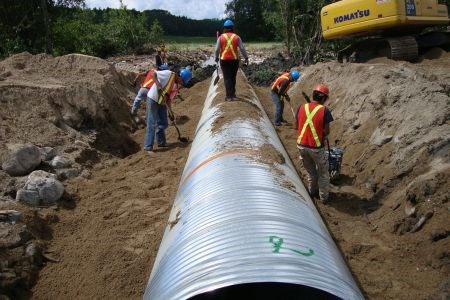Conrad Tom has a versatile and complicated job
Officially, he's listed as an Aboriginal Liaison for Miisun Integrated Resource Management, but he has one core function: building trust.
The First Nations-owned company in Kenora has taken some innovative, yet old-school approaches on resource sharing on the forestry and mining front.
Among his many duties, he takes the “$100 words” used by industry and government officials and translates them into terms regular folk can understand.
“I have to learn all the stuff they know,” said Tom, nodding to operations manager Shannon Rawn, “the forestry management and engineering part and the planning.”
Tom, who grew up near Sioux Narrows, is proving to be an invaluable resource for forestry and exploration companies by translating documents into Ojibway and conducting “values gathering” in identifying sensitive culture sites so they are not disturbed.
The company is contracted by Miitigoog LP, a co-operative SFL holder that runs a unique forest management unit in Ontario.
Structured similarly to the enhanced shareholder pilot model proposed in the province's Forest Tenure Act, Miitigoog is a 50/50 partnership to share management of the 1.2 million-hectare Kenora Forest between local First Nation communities and local forestry companies and contractors.
Weyerhaeuser signed over the licence to Miitigoog last October in an historic signing ceremony.
Handling the forestry operations is Miisun, a ive-employee management company located in the former offices of Abitibi Consolidated, across the street from the mostly demolished pulp and paper plant.
The five-employee outfit is keeping busy with service agreements and management contracts including the Kenora and Whiskey Jack Forests.
The group is developing long-term management plans for future logging operations.
“The amount of interest we've gotten is unreal,” especially from mining companies, said Rawn. “What we have is a 100 per cent First Nation company that has proven professionals in here with a First Nations liaison.”
Since First Nation consent and participation is key in resource development, Miisun has developed a proven strategy for consultation. Tom works alongside Marvin McDonald, who sits on Miitigoog's advisory committee, in handling natural resource-related consultation with area First Nation communities.
“The old way of consulting with First Nations hasn't worked, and doesn't work,” said Rawn.
If a company wanted to conduct harvesting operations near a First Nation community, only written notice was sent to the band office. If it went unanswered, it was often assumed consent had been granted.
Often the communities are unaware of forest management practices, such as slash pile burning.
Tom has been successful in making inroads in the 13 communities of the Kenora Forest, discussing boundaries and cultural values, subjects that are often off-limits to non-Aboriginals.
“They're very reluctant to give the government or an SFL holder information,” said Rawn.
Individual consultation isn't a 15-minute meeting. It can take hours and stretch on over the course of a month. It can be an exhausting and painstaking process.
“Three hours is the longest one I've had,” said Tom.
“Building that trust is not something that happens overnight,” said Rawn. “It can take three, four or five years.”
With permission of a band council, Tom approaches individual elders or trap line holders in a manner given to First Nation custom, talking Ojibway and with a gift of tobacco. “They feel more respected.”
Often they want someone to hear their story; about customs, what they've lost, experiences in residential school, social injustice, flooding problems, frustrations over land claims and past confrontations with industry. “I'm a sounding board, and I feel anger and all that emotion.”
He also brings back those concerns. “I'm also the messenger.”
His ability is raising interest from mining players in the area.
With mineral exploration projects in northwestern Ontario advancing into mine development near Dryden and Sioux Narrows, they hope to integrate the consultation strategy into the Treaty 3 Resource Law.
Eventually, Miisun hopes to train other Aboriginal liaisons to eventually take this “enhanced consultation” process province-wide.
“We have other companies interested in our model,” said Tom, mentioning Saskatchewan and in Eastern Canada.
Miisun's formula has attracted attention – and funding – from Indian and Northern Affairs Canada (INAC) “They want to see how we developed this and we're going to provide a report to them,” said Rawn.
Other than INAC money, Miisun doesn't receive any other government funding. The contracts with the First Nation and industry partners pay the salaries.
Tom said younger people are turning on to the job possibilities of participating in the region's developing natural resources sector.
Some are getting a taste for the industry by providing labour for a junior mining company operating in the Cameron Lake area.
When Tom visits a community, he's constantly looking for skilled and qualified individuals that can work on a bush road program, forestry-related activities and exploration support jobs.
If there are training opportunities, Miisun wants to get them signed up.
“We're not just forestry, we're resource managers,” said Rawn.




